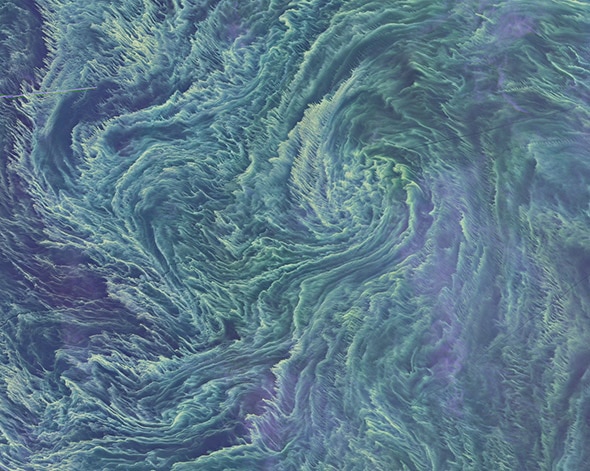Create a free profile to get unlimited access to exclusive videos, sweepstakes, and more!
Bloom With a View. Two of Them, in Fact.

Oh, I do so love a coincidence. And when it’s about imaging Earth from space, that’s even better.
I subscribe to NASA’s Earth Observatory Image of the Day (and you should, too!), which, oddly enough, posts an image of Earth every day. They’re almost always satellite shots, featuring various amazing portraits of our planet. As a satellite photo nerd I love it, and I learn a lot about Earth every time I see a new one. The cloud images alone are worth it.
One of the most spectacular and lovely kinds of photos they post are of phytoplankton blooms—huge bursts of growth (usually of cyanobacteria) in the ocean. Warmer waters can create conditions where nutrients and sunlight become abundant to the little plants, and they go forth and multiply. Blooms can be huge, hundreds of kilometers across.
The image above shows (a small part of) a bloom in the Baltic Sea, just north of Poland. It was taken by Landsat 8 on Aug. 11, and it’s not “true color,” that is, what your eye would see. The detectors used are sensitive to colors across a range of the spectrum, so the colors displayed are close to red, green, and blue, but there’s quite a bit of overlap (for example, the detector that sees in the green is also sensitive to yellow, and the blue one sees green as well). Still, the bloom is eerily beautiful. You can see airplane contrails and the wakes of ships in the original full-res image, too.
The spiral pattern is lovely, caused by eddies in the sea currents. Cyanobacteria are plants (more or less) so they flow along with the water.
The coincidence? The European Space Agency released a similar picture taken just a few days before, on Aug. 7, using the Sentinel-2 Earth-observing satellite:
Whoa. I’m not positive that’s the same swirl, but it’s from the same general area of the Baltic Sea (the Sentinel image is also part of a much larger image). Interestingly, both images from Landsat and Sentinel-2 show ships crossing their respective swirl; in each you can see the ship as a dot followed by a black trail.
Cyanobacterial blooms are important to study. They can rob water of oxygen and nutrients, and some phytoplanktons produce toxins that can be dangerous. And here we have two space agencies studying the same bloom at two different times with two different satellites! It’s really gratifying to see nations taking this sort of work seriously … especially when one faction of my own nation doesn’t.
We need to understand our planet as best we can. Not just because doing so produces such wonderful natural art, but because we are part of Nature ourselves, and we influence it just as it influences us. Understanding it is critical.
After all, Nature can live without us, but we can’t live without Nature.














